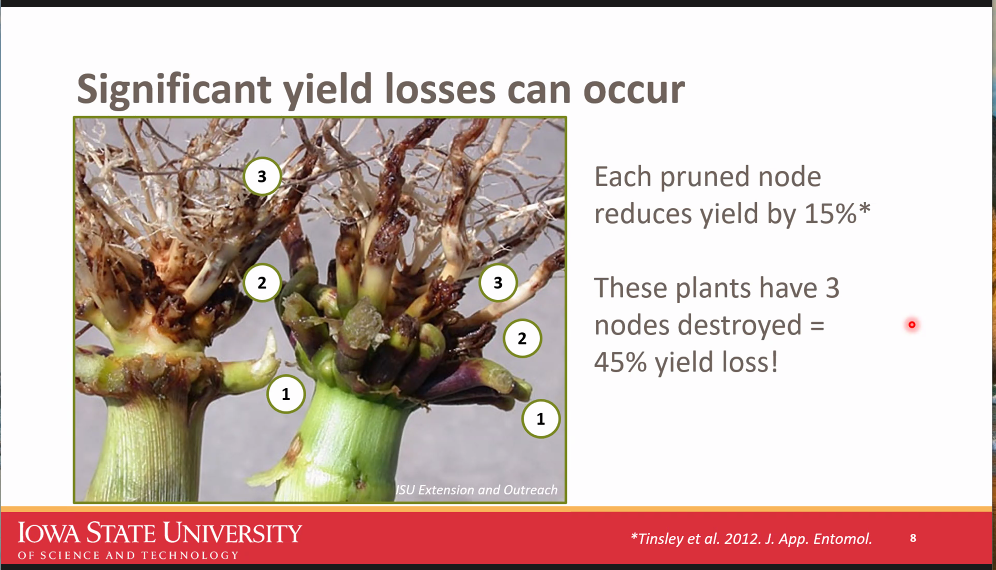Expect More Corn Rootworm Problems This Season

Farmers in some parts of the Midwest are likely to see more pressure from corn rootworm (CRW) this season than in recent years, say university entomologists.
Erin Hodges, Iowa State University Extension entomologist, cites several reasons. She says Iowa farmers should plan for corn rootworm if they had any of these contributing factors during the past two years: continuous corn, late-maturing hybrids, delayed and/or replanted fields, weedy fields and borders, and soybeans with significant volunteer corn.
During a recent webinar, Hodges says based on 2020 reports, the "number of problem fields (in Iowa) increased and the geographic range is expanding."
Parts of Illinois are also experiencing more CRW pressure.
“Farmers in northern and northwestern Illinois are seeing more corn rootworm, and it’s not limited to that area,” reports Nick Seiter, University of Illinois field entomologist.
Seiter adds that despite the upswing of CRW in some areas and regions, the good news is CRW populations across most states remain low.
Bt traits continue to falter. One of the key factors Seiter says is contributing to the population increase in Illinois is CRW resistance or partial resistance is common to the Cry3 proteins (Cry3Bb1, mCry3A and eCry3.1Ab).
He adds that reduced CRW susceptibility also exists to Cry34/35Ab1, but that problem is not as widespread as the Cry3 resistance. Seiter says most CRW trait packages in hybrids today contain Cry34/35Ab1 plus a Cry3 toxin.
Hodgson says she has confirmed field-evolved resistance to all four of the Bt traits for CRW with cross resistance between all three Cry3 proteins.
“Iowa farmers should assume some level of Cry3 resistance in all Iowa cornfields,” she says.
Hodgson adds that she has seen no cross resistance in Iowa with Cry34/35Ab1.
Most resistance problems farmers find are with western corn rootworm, though not all. “Resistance in northern corn rootworm was recently confirmed in North Dakota and is suspected elsewhere,” Seiter says.
For more insights on resistance problems and traits, farmers can consult the "Handy Bt Trait Table" at https://www.texasinsects.org/bt-corn-trait-table.html
Be prepared to dig up corn plants. The initial signs that corn rootworm is impacting a crop’s yield potential is not usually visible above ground.
“In most years, with adequate moisture, at least in Iowa, you’re not going to see above-ground signs of stress,” Hodgson says.
“You probably won't see any lodged corn, and you probably will see ears that are filled out pretty good,” she adds. “You often won’t see signs of increasing injury and declining yield until the end of the season.”
Farmers will need to dig up corn plants and evaluate root nodes for damage. “Root nodes contribute to nutrient and water uptake; when nodes are pruned plant vigor is compromised and yield loss results,” she says.
Hodges says severe pruning of a single root node contributes to approximately 15% yield loss.
She encourages farmers to assess root damage using the Iowa State University 0 to 3 node-injury scale, with 0 equal to no damage and 3 meaning 3 nodes of roots are pruned. Approximately 10 roots is equivalent to one node.
Hodges says If you are planting a pyramid corn hybrid this season – that means there are two CRW traits in the same hybrid – the EPA says you should not see greater than a .5 level of injury to a single node from larvae feeding. With a single trait hybrid, the EPA says you should never see a score above 1.
If traits are not performing as advertised, Hodges says you may want to contact your seed supplier.
In addition, Hodges and Seiter do not recommend layering Bt traits with a soil-applied insecticide. They give several reasons. The practice increases costs, won’t necessarily prevent root injury and can cover up a resistance problem.
Corn Rootworm Pressure To Persist In 2021 For Corn Belt
AMVAC Survey: Corn Rootworm Pressure Intensifies, Soil Insecticide Demand Will Rise
More Corn Rootworm Trait Failure








